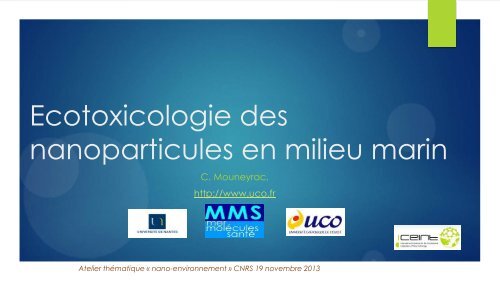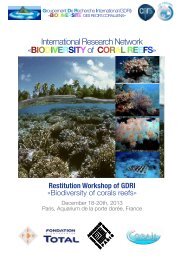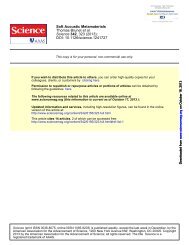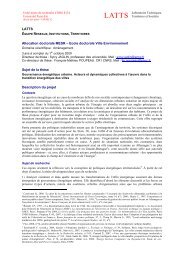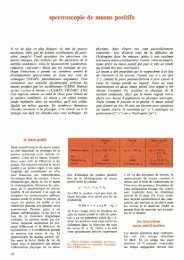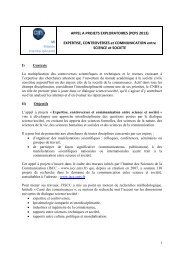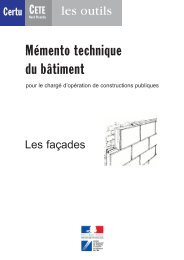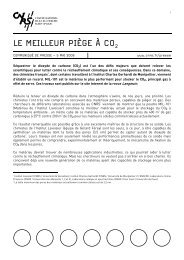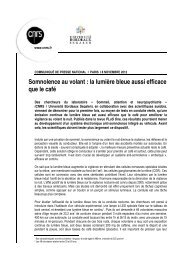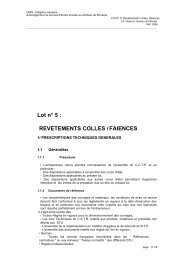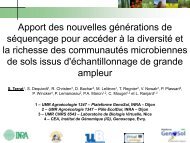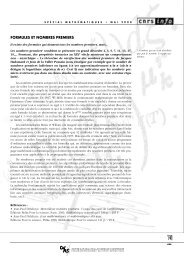Khan et al., 2012 - CNRS
Khan et al., 2012 - CNRS
Khan et al., 2012 - CNRS
Create successful ePaper yourself
Turn your PDF publications into a flip-book with our unique Google optimized e-Paper software.
Ecotoxicologie des<br />
nanoparticules en milieu marin<br />
C. Mouneyrac,<br />
http://www.uco.fr<br />
Atelier thématique « nano-environnement » <strong>CNRS</strong> 19 novembre 2013
Nanotechnology industry<br />
ENMs in estuaries and coast<strong>al</strong> waters:<br />
Relevance?<br />
Nano-products<br />
(ex: sunscreen…)<br />
Three main sources of ENPs in<br />
marine ecosystems:<br />
‣ Person<strong>al</strong> care products<br />
‣ Urban and seawage plants<br />
‣ Antifouling and paints<br />
Release of nano-residues<br />
Marine organism models<br />
‣ Filter feeders<br />
‣ Pelagic species<br />
‣ Benthic species<br />
Food web<br />
‣ 40 000 km3/year of freshwater flows into the worldwide oceans through the main rivers.<br />
‣ The major part of this freshwater water is not treated before reaching the rivers.<br />
‣ ENMs accident<strong>al</strong>ly or not (usage, end of life) released in the environment reach estuarine or<br />
coast<strong>al</strong> areas.<br />
Atelier thématique « nano-environnement » <strong>CNRS</strong> 19 novembre 2013
Key questions ?<br />
Transformations?<br />
Fate and behaviour ?<br />
Can they be transformed?<br />
What do they become?<br />
Which concentrations?<br />
Do transformations affect<br />
Interaction with<br />
living organisms?<br />
Uptake?<br />
Bioavailablility?<br />
Bioaccumulation?<br />
Loc<strong>al</strong>ization?<br />
Toxicity effects?<br />
toxicity? Which mechanisms ?<br />
Transfer in the food web?<br />
Atelier thématique « nano-environnement » <strong>CNRS</strong> 19 novembre 2013
Aggregation in seawater?<br />
Artifici<strong>al</strong> medium<br />
Natur<strong>al</strong> medium<br />
A higher aggregation rate of Ag NPs in seawater due to the<br />
reduction of electric repulsion force and energy barrier b<strong>et</strong>ween<br />
nanoparticles. Cl - promote bridges b<strong>et</strong>ween NPs<br />
Atelier thématique « nano-environnement » <strong>CNRS</strong> 19 novembre 2013
Does aggregation reduces<br />
bioavailability?<br />
Citrate capped Ag NPs<br />
Increase in aggregation at higher s<strong>al</strong>inities<br />
Solubility study<br />
<strong>Khan</strong> <strong>et</strong> <strong>al</strong>., <strong>2012</strong><br />
Atelier thématique « nano-environnement » <strong>CNRS</strong> 19 novembre 2013<br />
No d<strong>et</strong>ectable release<br />
of dissolved Ag over<br />
24hr solubility in 1mM<br />
NaNO3.
Biodynamic model<br />
Biodynamic param<strong>et</strong>ers<br />
Peringia ulvae<br />
Lymnaea stagn<strong>al</strong>is<br />
• Dissolved Ag is more available than Ag NPs in both species<br />
• Both forms are more bioavailable in freshwater<br />
• Ag bioavailability is reduced by greater complexation of Ag + in<br />
seawater and increased agregation<br />
<strong>Khan</strong> <strong>et</strong> <strong>al</strong>., <strong>2012</strong><br />
Atelier thématique « nano-environnement » <strong>CNRS</strong> 19 novembre 2013
Do NPs can be incorporated in biologic<strong>al</strong> tissues?<br />
Bioaccumulation of gold nanoparticles in the clam Scrobicularia plana<br />
Pan <strong>et</strong> <strong>al</strong>., <strong>2012</strong>, Environment<strong>al</strong> Pollution<br />
Loc<strong>al</strong>ization within the<br />
nuclei<br />
coloc<strong>al</strong>ized with DNA<br />
Atelier thématique « nano-environnement » <strong>CNRS</strong> 19 novembre 2013<br />
Joubert <strong>et</strong> <strong>al</strong>., 2013<br />
Gold Bull<strong>et</strong>in
Uptake and loc<strong>al</strong>ization of TiO 2 NPs on<br />
mussels?<br />
Uptake of TiO2 NP<br />
by microvilli of digestive cells,<br />
lysosom<strong>al</strong> loc<strong>al</strong>ization<br />
Atelier thématique « nano-environnement » <strong>CNRS</strong> 19 novembre 2013<br />
Barmo <strong>et</strong> <strong>al</strong>., Aquat. Toxicol., 2013
Do bioaccumulated NPs have noxious effects?<br />
Classic<br />
<br />
Multi-marker approach: Endpoints at<br />
different levels of the biologic<strong>al</strong><br />
organization<br />
and recent<br />
<br />
Individu<strong>al</strong> level: surviv<strong>al</strong>/mort<strong>al</strong>ityy, growth,<br />
reproduction, behaviour (burrowing,<br />
feeding rate<br />
Ecologic<strong>al</strong><br />
Relevance<br />
biomarkers<br />
<br />
Sub-individu<strong>al</strong> level: biochemic<strong>al</strong><br />
biomarkers (oxydative stress, genortoxicity,<br />
lysosom<strong>al</strong> membrane destabilization,<br />
neurotoxicity)<br />
« omics » approaches to unravel toxicity<br />
mechanisms<br />
Atelier thématique « nano-environnement » <strong>CNRS</strong> 19 novembre 2013
Do bioaccumulated NPs have noxious effects?<br />
Oxydative stress, lipid<br />
peroxydation, genotoxicity,<br />
lysosom<strong>al</strong> membrane<br />
destabilization,<br />
immunotoxicity,<br />
inflammation,neurotoxicity,<br />
behaviour<br />
Atelier thématique « nano-environnement » <strong>CNRS</strong> 19 novembre 2013<br />
Canesi <strong>et</strong> <strong>al</strong>., <strong>2012</strong>, MER
Proteomic an<strong>al</strong>ysis of mussels exposed<br />
to CuO NPs<br />
‣ CuO NPs <strong>al</strong>tered the expression of three proteins involved in apoptosis(caspase 3/7–<br />
1), oxidative stress responses (GST) and proteolysis (cathepsin L),<br />
‣ Cu2+ increased the expression of one protein related to adhesion and cell mobility<br />
(precollagen–D).<br />
Atelier thématique « nano-environnement » <strong>CNRS</strong> 19 novembre 2013<br />
Gomes <strong>et</strong> <strong>al</strong>., 2013, PhD
Combine effects of NMs and other<br />
pollutants ?<br />
‣ Dissimilar b<strong>et</strong>ween<br />
species and NMs<br />
‣ TiO 2 NPs enhance<br />
bioaccumulation<br />
and toxicity<br />
Wong <strong>et</strong> <strong>al</strong>., 2013,<br />
Reviews in Nanoscience<br />
and Nanotechnology<br />
Atelier thématique « nano-environnement » <strong>CNRS</strong> 19 novembre 2013
Fate and toxicity effects 67 ZnO NPs<br />
Sediment Exposure: Environment<strong>al</strong> re<strong>al</strong>istic dose: 3 mg.Kg -1 (Tiede <strong>et</strong> <strong>al</strong>. 2009)<br />
67<br />
Zn Natur<strong>al</strong> abundance: 4.1%<br />
67 Zn Bioaccumulation<br />
67 Zn in sediments<br />
Scrobicularia plana<br />
Labeled 67 Zn on sediment surface and migration in the<br />
first centim<strong>et</strong>ers<br />
Nereis diversicolor<br />
Moderate toxicity effects (oxidative stress,<br />
behavior)<br />
Atelier thématique « nano-environnement » <strong>CNRS</strong> 19 novembre 2013<br />
Bioturbation processes operated by benthic<br />
species could contribute to this migration<br />
Buff<strong>et</strong> <strong>et</strong> <strong>al</strong>., <strong>2012</strong>
What happens in the re<strong>al</strong> life?<br />
complexity,<br />
medium/long term,<br />
ecologic<strong>al</strong> relevance<br />
replicability, low cost<br />
Lab conditions<br />
•Natur<strong>al</strong> sea water<br />
Outdoor Mesocosm<br />
• Tid<strong>al</strong> cycle<br />
• Micro<strong>al</strong>gae migrations<br />
• Environment<strong>al</strong> anim<strong>al</strong> density<br />
Atelier thématique « nano-environnement » <strong>CNRS</strong> 19 novembre 2013
Future research needs…<br />
• The development of new and more robust m<strong>et</strong>hods and techniques for<br />
the d<strong>et</strong>ection and characterization of nanomateri<strong>al</strong>s in complex<br />
environment<strong>al</strong> matrices (water, soil/sediment).<br />
• Need of standardized protocols/ NM references<br />
• What m<strong>et</strong>ric provides the best measure of dose? Progress with the<br />
relationships b<strong>et</strong>ween NM physico-chemic<strong>al</strong> properties (aggregation,<br />
surface modifications, dissolution mechanisms, redox processes) and<br />
ecotoxicologic<strong>al</strong> effects<br />
• What are re<strong>al</strong>istic environment<strong>al</strong> concentrations ?<br />
• Development and v<strong>al</strong>idation of exposure estimation models <strong>al</strong>lowing<br />
the d<strong>et</strong>ermination of re<strong>al</strong>istic exposure scenarios (intensity/frequency)<br />
through NM life-cycle.<br />
Atelier thématique « nano-environnement » <strong>CNRS</strong> 19 novembre 2013
Future research needs…<br />
• Toxicity effects: classic<strong>al</strong> approach, new specific approach?<br />
• Environment<strong>al</strong> modulations on toxicities of NMs<br />
• Ionic strength/s<strong>al</strong>inity<br />
• Temperature<br />
• pH<br />
• UV light<br />
• NOM<br />
• Other pollutants<br />
• Influence of ageing and non ageing of NPs on their behaviour and<br />
biologic<strong>al</strong> effects<br />
• Bioaccumulation/Food chain transfer: Mesocosm approach<br />
Atelier thématique « nano-environnement » <strong>CNRS</strong> 19 novembre 2013


